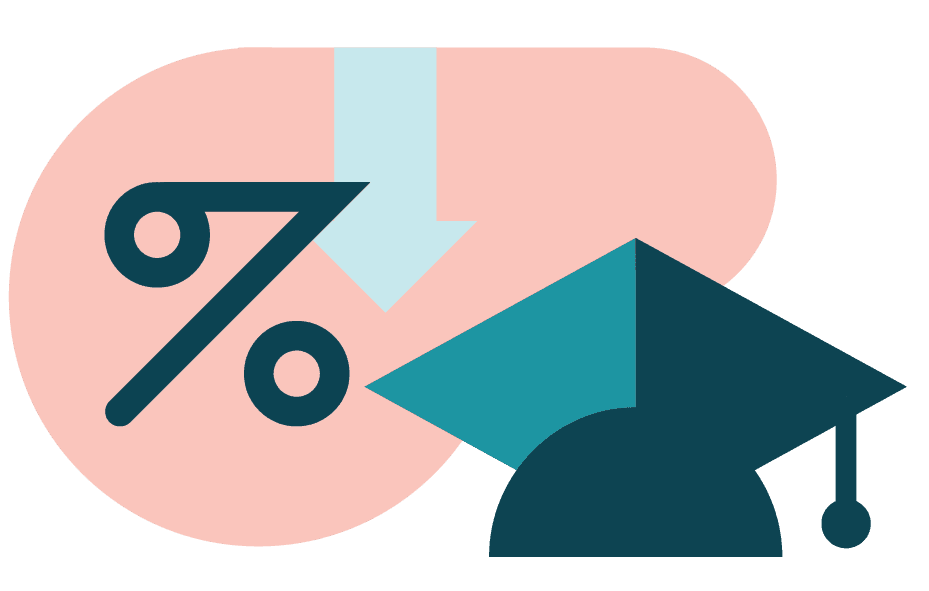Credible takeaways
- Refinancing could help you lower your interest rate, especially if you have good credit and stable income.
- Many lenders will reduce your interest rate by 0.25 percentage points if you sign up for autopay.
- The faster you pay off your student loans, the less interest you’ll pay over time.
Paying off a student loan with a high interest rate can take a lot of time and money. But if you can reduce your rate, you’ll likely spend less on interest charges and may even pay off your loan faster. In this guide, we’ll explore six effective ways to lower your student loan interest rate.
1. Refinance your student loans
Student loan refinancing lets you pay off private or federal loans with high interest rates by taking out a new loan with different repayment terms.
Refinancing could get you a lower student loan interest rate, which would save you money on interest charges over time. You also have the option to refinance more than once if you qualify for even better loan terms later on.
If you decide to refinance, remember to consider as many lenders as you can to find a loan that fits your needs. Not all lenders will offer you the same rate or terms for student loan refinancing, so you’ll want to compare the best student loan refinance lenders before you make a decision.
Important:
Be cautious when refinancing your federal loans as you’ll lose access to federal benefits like income-driven repayment plans and loan forgiveness programs.
Credible rating
Fixed (APR)
5.48% -
Loan Amounts
$10,000 up to total refinance amount
Min. Credit Score
680
Credible rating
Fixed (APR)
5.49% -
Loan Amounts
$5,000 - $250,000
Min. Credit Score
680
Credible rating
Fixed (APR)
5.85% -
Loan Amounts
$5,000 - $250,000
Min. Credit Score
670
Credible rating
Fixed (APR)
6.00% -
Loan Amounts
$7,500 - $200,000
Min. Credit Score
700
Credible rating
Fixed (APR)
6.20% -
Loan Amounts
$10,000 up to the total amount
Min. Credit Score
670
Credible rating
Fixed (APR)
6.34% -
Loan Amounts
$7,500 - $250,000
Min. Credit Score
680
Credible rating
Fixed (APR)
6.49% -
Loan Amounts
$10,000 - $750,000
Min. Credit Score
Does not disclose
All APRs reflect autopay and loyalty discounts where available | LightStream disclosure | SoFi Disclosures | Read more about Rates and Terms
If you don't want to refinance federal student loans, another option is to consolidate them through a Direct Consolidation Loan. Consolidating your federal debt won’t necessarily reduce your interest rate like refinancing does, but it could extend your repayment term and lower your monthly payment. Just remember that having a longer term means you’ll pay more in interest over time.
2. Sign up for autopay
One of the quickest ways to get a rate discount is to check if your lender or loan servicer offers an automatic payment discount. Most autopay discounts reduce your rate by 0.25 percentage points. That might not seem like a lot, but every little bit helps.
Here's how an autopay discount could lower your student loan costs, assuming a 10-year repayment term.
For example, if your total student loan debt is $40,000, that small rate discount can save you more than $600 over the life of a loan. You’ll save even more if your loan balance is higher.
In addition to lowering your interest rate, authorizing automatic payments can:
- Help you stay current on your loans
- Avoid costly late fees and damage to your credit score
- Help you improve your credit by establishing a history of on-time payments
3. Look for loyalty discounts and more
Some lenders also offer loyalty discounts to borrowers who already have a relationship with them. These rate discounts are typically 0.25%, depending on the lender.
For example, if you already have an account with Citizens and refinance your student loans through them, you might qualify for a 0.25% rate discount. Or if you refinance with SoFi and are already a member, you could get a 0.125% rate discount.
Because borrowers who earn their degrees are less likely to default on their loans, you might also be able to earn rewards on private student loans for earning good grades or graduating. Ask your lender if there are any other discounts you qualify for. You might be surprised at how much lower you can get your rate.
4. Raise your credit score
To qualify for the lowest-advertised refinancing rates, you typically need excellent credit. If you have poor or fair credit, consider improving your credit first so you can qualify for a lower interest rate later on.
Here are several ways to potentially raise your score:
- Review your credit report: Check your credit report to ensure there are no errors or fraudulent accounts in your name. If you find any inaccurate information, dispute the accounts with the major credit bureaus: Experian, Equifax, and TransUnion. Having incorrect information removed from your report could improve your score within a few weeks.
- Make payments on time: Your payment history comprises 35% of your FICO credit score. To boost your credit, be sure to pay all of your bills on time. Keep in mind that past missed payments can stay on your credit report for up to seven years. However, the longer you make on-time payments, the less impact any missed payments will have on your overall score.
- Pay down debt: Your credit utilization makes up 30% of your FICO credit score. To reduce your credit utilization (how much of your available credit you use), make extra payments toward your existing accounts, such as credit cards or student loans. As you lower your credit use, your score will gradually improve.
Keep in mind:
It generally takes about six months of following these steps to see a difference in your credit. The longer you stick to these behaviors, the more your credit should improve.
5. Use a cosigner when refinancing
If you have less-than-perfect credit, you might be able to lower your interest rates by refinancing your student loans with a cosigner. A cosigner is typically a relative or trusted friend with good or exceptional credit as well as reliable income who will share responsibility for the loan.
Adding a cosigner to your loan reduces the risk to the lender, which could improve your chances of qualifying for a lower interest rate. Adding a cosigner also doesn't have to be permanent. Some lenders offer cosigner release, which lets you remove a cosigner from the loan if you meet certain requirements.
To qualify for cosigner release, you’ll typically need to:
- Make consecutive, on-time payments for a specific amount of time (often 12 to 48 months, depending on the lender)
- Meet the lender’s eligibility criteria (such as credit score and income requirements) on your own
6. Negotiate with your current lender
While this strategy isn’t guaranteed, one way to potentially lower your interest rate is to negotiate with your current lender.
If you’ve improved your creditworthiness by increasing your income, paying down debt, or boosting your credit score, your lender might be willing to reduce your rate.
Before negotiating, consider shopping around with other refinancing lenders to get rate offers. Once you have these quotes, contact your lender to say you’re considering taking out a loan from another company, and see if the lender will give you a lower interest rate.
If you have a good history with the lender, it might be willing to counteroffer to keep you as a customer.
Keep in mind that this strategy won’t work for federal student loans — since you can’t switch servicers, there’s no incentive for your servicer to lower your rates. But if you have private student loans, this might be an effective way to score a reduced rate.
More ways to save on student loans
If you’re not able to lower your student loan interest rates, there are other ways to tackle your student debt. Here are a few other ways you could pay off your loans faster:
1. Pay more each month
Try making larger monthly payments rather than the minimum amount due. While you may not lower your interest rate, you’ll pay less in interest over the life of the loan since you’ll be out of debt sooner.
You can also work toward making an extra payment on your student loans, whether it’s every other month or once a year.
2. Deduct interest costs on your taxes
If you made payments toward your student loans, you might qualify for the student loan interest tax deduction, which can reduce your taxable income. With the tax deduction, you can deduct $2,500 or the amount of interest you paid during the tax year — whichever is less.
There are income restrictions on who qualifies for the deduction, and you’ll need to have qualifying loans. But if you’re eligible, taking advantage of the deduction could help you save money.
3. Avoid alternative payment plans
Income-driven repayment plans are helpful if you can’t afford to make on-time minimum payments on your federal loans every month. But they can extend your loan terms from 10 years to as long as 25 years. That’s a long time to be paying back your loans.
If you stick to the standard repayment plan, your debt will be paid in full within a decade. When you extend your loan term, you may get a lower monthly payment, but you can end up paying a lot more in interest.
4. Use the debt avalanche method
If you want to reduce how much you pay in interest, using the debt avalanche method could be a good way to manage your loans. By using this approach, you’ll tackle the most expensive debt first — which will save you money on interest charges and help you pay off your loans faster.
Here’s how the debt avalanche method works:
- List all of your outstanding debts
- Pay extra on your debt with the highest interest rate
- Once that's paid off, move to the next-highest interest rate
- Continue to pay the minimum on everything else
- Repeat until all debt is paid
Lower student interest rate FAQ
Get answers to frequently asked questions about how to lower your student loan interest rate.
What if my student loan interest rate is too high?
If your student loan interest rate is too high, consider refinancing to potentially lower your rate. You can generally qualify for a lower interest rate if you have a good credit score and a steady income. It's important to note that refinancing your federal loans isn’t typically advisable since you’d lose benefits like income-driven repayment and forgiveness programs.
How do I pay the least interest on student loans?
To pay the least amount of interest possible on your student loans, consider strategies for lowering your interest rates. For example, refinancing might allow you to qualify for a lower interest rate on your private loans if you have good credit.
Additionally, paying off your loans early by making extra payments when you can is an effective way to save money on overall interest costs.
Is 7% interest high for student loans?
A 7% interest rate on a student loan could be high or low depending on the average rate for your loan type at the time you apply. In 2023, interest rates for federal student loans were between 5.50% and 8.05%. Private student loan interest rates tend to fluctuate more. The week of December 18, 2023, interest rates on a 10-year fixed rate loan averaged 7.56% and 11.46% on a 5-year variable rate loan.


